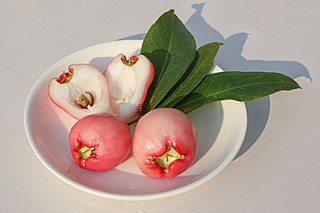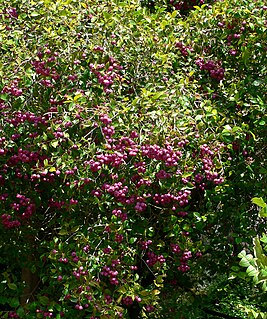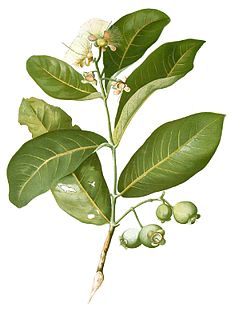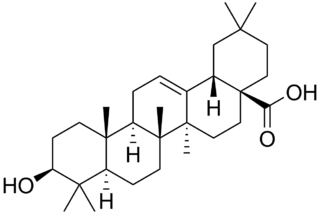
Syzygium samarangense is a plant species in the family Myrtaceae, native to an area that includes the Greater Sunda Islands, Malay Peninsula and the Andaman and Nicobar Islands, but introduced in prehistoric times to a wider area and now widely cultivated in the tropics. In Indonesia it is known as Jambu Air.

Syzygium is a genus of flowering plants that belongs to the myrtle family, Myrtaceae. The genus comprises about 1200–1800 species, and has a native range that extends from Africa and Madagascar through southern Asia east through the Pacific. Its highest levels of diversity occur from Malaysia to northeastern Australia, where many species are very poorly known and many more have not been described taxonomically.

Syzygium cumini, commonly known as jambolan, Java plum, black plum or jamun, is an evergreen tropical tree in the flowering plant family Myrtaceae. It is native to the Indian Subcontinent, adjoining regions of Southeast Asia, China and Queensland. The name of the fruit is sometimes mistranslated as blackberry, which is a different fruit in an unrelated order. Syzygium cumini has been spread overseas from India by Indian emigrants and at present is common in former tropical British colonies.

Syzygium smithii is a summer-flowering, winter-fruiting evergreen tree, belonging to the myrtle family Myrtaceae. It shares the common name "lilly pilly" with several other plants. In New Zealand, it is commonly known as 'monkey apple'. It is planted as shrubs or hedgerows, and features: rough, woody bark; cream and green smooth, waxy leaves; flushes of pink new growth; and white to maroon edible berries. Unpruned, it will grow about 3–5 m (9.8–16.4 ft) tall in the garden.

The magenta lilly pilly, also known by the common name magenta cherry, is a broad dense bushy rainforest tree native to New South Wales. It grows to a height of 15 m with trunk diameter up to 35 cm. Leaves are 3–9 cm long, opposite, simple and slightly obovate, tapering at the leaf base. The leaves are dark glossy above, and paler below. White flowers are produced in clusters. The edible fruit is usually magenta, but can be white, pink or purple.

Syzygium malaccense is a species of flowering tree native to Malesia and Australia. It is one of the species cultivated since prehistoric times by the Austronesian peoples. They were carried and introduced deliberately to Remote Oceania as canoe plants. In modern times, it has been introduced throughout the tropics, including many Caribbean countries and territories.
Syzygium calcadensis is a species of plant in the Myrtaceae family. It is endemic to Tamil Nadu in India.
Syzygium beddomei is a species of plant in the Myrtaceae family. It is endemic to Tamil Nadu in India.
Syzygium densiflorum is a species of plant in the Myrtaceae family. It is endemic to India.
Syzygium microphyllum is a species of plant in the Myrtaceae family. It is endemic to India. It is threatened by habitat loss. In 1998 the now disputed taxon Syzygium gambleanum was listed as extinct in the IUCN Red List. However, after research work by the Royal Botanic Gardens Kew this plant was revealed as identical with Syzygium microphyllum and so the name Syzygium gambleanum became an illegitimate synonym.
Syzygium neesianum is a species of plant in the Myrtaceae family. It is endemic to Sri Lanka.
Syzygium ramavarmae is a species of plant in the Myrtaceae family. It is native to Kerala and Tamil Nadu in India.
Syzygium rotundifolium is a species of plant in the Myrtaceae family. It is endemic to Sri Lanka.
Syzygium cordifolium is a species of plant in the Myrtaceae family. It is endemic to Sri Lanka.

Syzygium aqueum is a species of brush cherry tree. Its common names include watery rose apple; names like "water apple" and "bell fruit" may refer to any species of Syzygium grown for its fruit.

Syzygium australe, with many common names that include brush cherry, scrub cherry, creek lilly-pilly, creek satinash, and watergum, is a rainforest tree native to eastern Australia. It can attain a height of up to 35 m with a trunk diameter of 60 cm. In cultivation, this species is usually a small to medium-sized tree with a maximum height of only 18m.

Oleanolic acid or oleanic acid is a naturally occurring pentacyclic triterpenoid related to betulinic acid. It is widely distributed in food and plants where it exists as a free acid or as an aglycone of triterpenoid saponins.
Syzygium guineense is a leafy forest tree of the Myrtaceae family, found in many parts of Africa both wild and domesticated. Both its fruits and leaves are edible; the pulp and the fruit skin are sucked and the seed discarded. It is sometimes called "waterberry", but this may also refer to other species of Syzygium.

Syzygium antisepticum, or shore eugenia, is native to Maritime Southeast Asia.

Syzygium polyanthum, with common names Indian bay leaf and Indonesian bay leaf, is a species of plant in the Myrtaceae family, native to Indochina and Malesia. The leaves of the plant are traditionally used as a food flavouring, and have been shown to kill the spores of Bacillus cereus.














